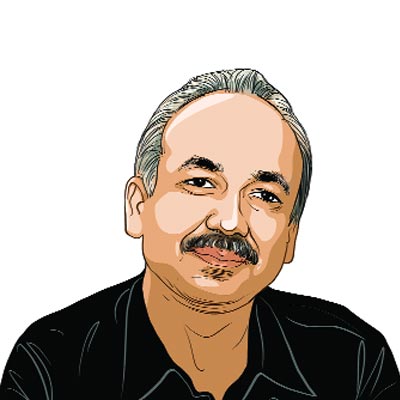Opinion Akhand Bharat doublespeak, cosying up to BJP and temple visits: The compromises of Nepal PM Prachanda, the communist
Given his precarious political position, Nepal's prime minister has come to realise that he needs to make several compromises, and align with the BJP as well. Having to frequent temples and be seen as a Hindu leader is a part of this compulsion
 Prime Minister Narendra Modi with his Nepal counterpart Pushpa Kamal Dahal 'Prachanda' in New Delhi. (PTI file)
Prime Minister Narendra Modi with his Nepal counterpart Pushpa Kamal Dahal 'Prachanda' in New Delhi. (PTI file) Back home from a four-day official visit to Delhi earlier this month, Prime Minister Pushpa Kamal Dahal “Prachanda” finds himself more politically rattled than before.
Something he said in the parliament contradicted his claims regarding the visit in Delhi. There, he said he did not raise the issue of border dispute or the inclusion of Lumbini and Kapilvastu in the “Akhand Bharat” murals inside India’s new Parliament building in order to avoid any kind of bitterness in the bilateral relationship. Back home, he said he did raise these issues and that Indian Prime Minister Narendra Modi was convinced they should be sorted out within the existing bilateral mechanism.
Prachanda tried to appear happy over what he claimed was a welcome on par with what was accorded to Donald Trump during his India visit. The inclusion of Nepali territory in the mural has provoked two mayors — Balen Shah of Kathmandu and Harka Sampang of Dharan — to hang a map of Nepal that includes the areas of disputed Kalapani, Lipulek and Limpiadhura on their office walls. These may be the usual actions and reactions that are at times associated with a high-level visit abroad, but Prachanda is also making extra efforts to act like a “religious” Hindu. He told parliament that he would have disappointed a billion Indians if he had not gone to the Mahakaleshwar Temple in Ujjain, but he knew the temple issue would now impact his politics.
The first pilgrimage Prachanda publicly made in Nepal was to Pashupati Nath on June 8, along with the set of ministers who were with him in Ujjain and spent 35 minutes there during the evening aarti, fuelling speculations that there will be many more such visits in his future political journey now.
In the past, BJP leaders have approached top leaders from Nepal — before the constitution was promulgated in 2015 — to restore the country’s “Hindu status”. Nepali Congress leader Sher Bahadur Deuba is believed to have told them that all he would try is to not have the word “secular” mentioned in it. K P Oli , another communist leader, while maintaining silence about the suggestion, began mobilising Hindus for political purposes. Like Prachanda now, he visited the Pashupati Nath temple with his wife and offered 108 kg gold, bought from the state. But it was a secular constitution that came about.
Prachanda now seems ready to compete with Oli, his communist rival, and, on the other, neutralise the aggressive campaign for the restoration of Nepal’s Hindu kingdom status. This is happening at a time when political parties are divided, and the central figure of the radical transition is not only confused and visibly on the decline but is also in a mood to compromise for survival.
No one knows how many more compromises Prachanda will have to make, but the current climate does not favour him. The supreme court last week admitted a petition filed by erstwhile child soldiers that Prachanda had recruited for the “people’s war” he led for a decade from 1996 to 2006 , seeking the trials of both Prachanda and Baburam Bhattarai (the head of the “people’s government”) for crimes against humanity. Some have already demanded his resignation, following the admission of the petition.
But Dahal has few defenders in parliament and outside. He leads the third-largest party with just 32 members in a House of 275. Both China and India have a visible stance on Nepal’s internal politics. While China wants the two big communist parties led by Prachanda and Oli to unite and form the government, India acts to keep them apart, in order to contain China’s growing influence.
Prachanda has been the beneficiary of this political dilemma but he has come to realise that he needs to make several compromises, and align with the BJP as well. Having to frequent temples and be seen as a Hindu leader is a part of this compulsion. It will automatically lead him to drift away and minimise his dealings and interactions with China including discouraging investment in key sectors like hydro and security.
The writer is a journalist based in Kathmandu






